Release 2 (9.0.2)
Part Number A95917-01
Home |
Solution Area |
Contents |
Index |
| Oracle9iAS Syndication Server User's and Administrator's Guide Release 2 (9.0.2) Part Number A95917-01 |
|
This chapter provides a brief overview of the Syndication Server Manager for Oracle Enterprise Manager (OEM) used for Syndication Server administration tasks.
Syndication Server Manager, a Web-based administration tool available through Oracle Enterprise Manager lets you administer Oracle9iAS Syndication Server. Syndication Server administration tasks are organized into the following management tasks:
Figure 4-1 provides an overview of the Syndication Server management tasks that can be performed, and the relationship among some of these tasks. In addition, the relationship of some tasks performed at runtime, such as creating subscriptions and schedulers, are shown to provide a better understanding of how Syndication Server works, along with some of the required packages needed to register content providers and subscriber applications.
Each of these tasks is described in more detail in Section 4.1.1 through Section 4.1.8.
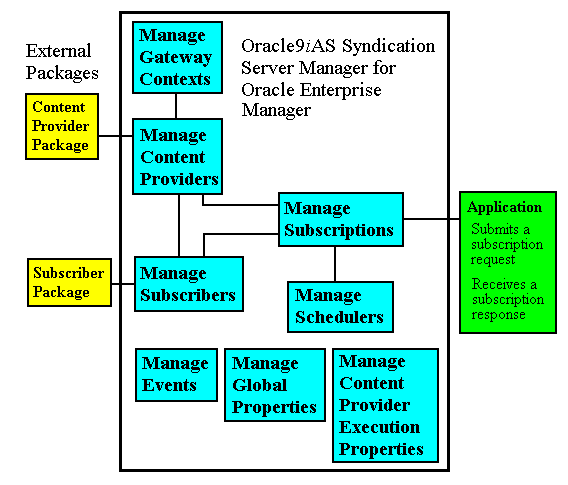
From the Subscribers window, you can:
Figure 4-2 shows a flow diagram of the Manage Subscriber tasks that you can perform from the Subscribers window.
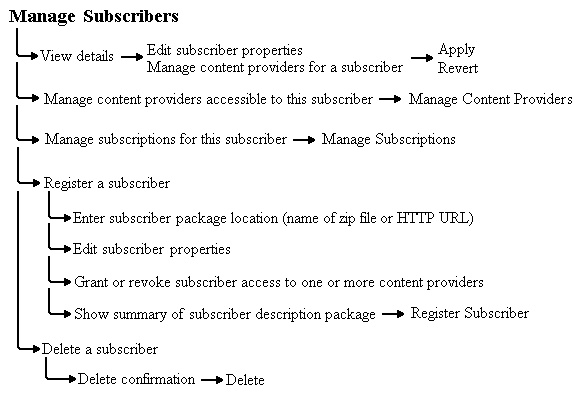
From the Subscriptions window, you can:
Figure 4-3 shows a flow diagram of the Manage Subscription tasks that you can perform from the Subscriptions window.
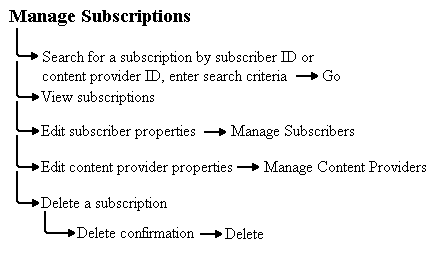
From the Content Providers window, you can:
You must register each content provider using the Register Content Provider wizard available on the Content Providers window.
Figure 4-4 shows a flow diagram of the Manage Content Provider tasks that you can perform from the Content Providers window.

After Syndication Server approves a subscription, it creates a scheduler (a DBMS_JOB instance residing in an Oracle database) for each delivery rule that has the delivery mode set to push and sends it to the scheduler.
Information for each scheduler includes:
Figure 4-5 shows a flow diagram of the Manage Scheduler tasks that you can perform from the Schedulers window.
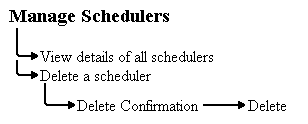
A gateway context represents a content provider's connection with all its properties to a content provider instance. Each content provider registers all of its content services with one content provider instance, which is defined by its gateway context. For better performance and load balancing, a content provider should register its content services with different content provider instances, that is, it should consider using different Gateway Context IDs.
Gateway Context Properties include the following information:
Enter a connection URL using the following syntax:
jdbc:oracle:oci8:@<tns-name-entry-to-where-content provider-instance-is-installed>
or
jdbc:oracle:thin@<your-host-name>:<your-port-number>:<tns-name-entry-to-wher e-content-provider-instance-is-installed>
The connection URL represents your database transport network service name (tnsname) or service identifier for using either the oci8 driver or the thin driver. This connection URL connects you to the instance to where the content provider registers all of its content services.
Figure 4-6 shows a flow diagram of the Manage Gateway Contexts tasks that you can perform from the Gateway Contexts window.
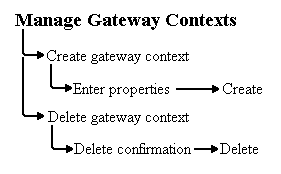
The Syndication Server global properties that you can manage include:
Figure 4-7 shows a flow diagram of the Manage Global Properties tasks that you can perform from the Global Properties window.

Event information includes:
Events are logged at three levels depending on first, whether the OSS_LOGGING_ENABLED global property is set to true or enabled, and second, the level of logging specified for the OSS_LOGGING_LEVEL global property, which is:
This is the minimal level of logging Syndication Server events and returns the status of the event as SUC (successful) or FAIL (failed).
This logs major steps of Syndication Server events, including the event status as successful or failed, and any warning messages that were generated.
This is the most detailed level of logging of Syndication Server events and returns the major steps of Syndication Server events, including the event status as successful or failed, any warning messages that were generated, and detailed trace information to help debug problems.
Figure 4-8 shows a flow diagram of the Manage Events tasks that you can perform from the Events window.

Before you start the event listener daemon to begin listening for Syndication Server events, you must enable system logging from Manage Global Properties so these events can be written to the log file. Set OSS_LOGGING_ENABLE to true to enable system logging, then start the event listener daemon. To start the event listener daemon, run the following command:
In UNIX: $ORACLE_HOME/syndication/bin/ossmon -u dsgateway -e start In Windows: $ORACLE_HOME\syndication\bin\ossmon -u dsgateway -e start
The event listener daemon displays the following information as it starts up:
Oracle Syndication Server Monitor Starting up... OSS_EV_LOGGING: Init of Oracle AQ... OSS_EV_LOGGING: Init of Oracle AQ... Done. OSS_EV_LOGGING: Monitor added. OSSEvM.init: All Monitors initialized Inside run() WHILE-Loop Oracle Syndication Server Starting up... Done. Right before Dequeue...
You can manage the following content provider execution properties:
If you are accessing the Internet from within a firewall, select Access the Internet using a proxy server, then enter the address of your proxy server and its port number.
Caching is enabled or disabled for all packages at the content provider execution level. Note that this setting takes precedence over any response caching parameters set in the package.
To cache all responses in the Oracle database at the execution level, select Enable caching for all content provider responses.
Caching is done by storing content provider responses indexed by their corresponding content provider requests. When performing cache lookup operations, a full XML comparison is made between the incoming request and the requests used to index the responses. During this comparison, white space differences can be ignored or noted. Choosing to ignore white spaces implies a looser match and therefore a more frequent use of the cache, thereby increasing performance from the application's perspective.
To ignore white space in service requests or more frequent use of the cache, select Ignore white spaces in content provider requests for cache lookup operations.
To select the level of debug logging you want written to the Web server log file, go to the pull-down menu and make a selection. The options are:
Figure 4-9 shows a flow diagram of the Manage Content Provider Execution Properties tasks that you can perform from the Content Provider Execution Properties window.
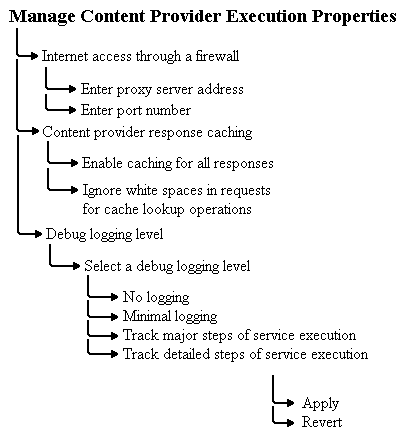
|
|
 Copyright © 2002 Oracle Corporation. All Rights Reserved. |
|